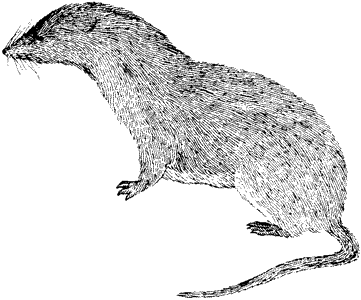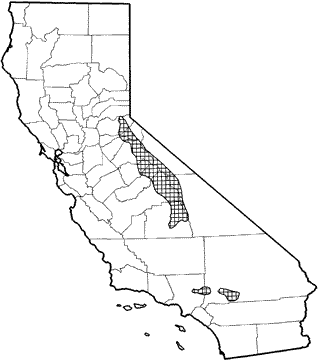
Dusky Shrew
Distribution, Abundance, and Seasonality
The dusky shrew is found in the high Sierra Nevada from Plumas Co. to Tulare Co., and in isolated populations in mountains of San Bernardino, Los Angeles, and Santa Barbara cos. It is common in montane riparian and alpine dwarf-shrub habitats; fairly common in subalpine conifer, wet meadow, and high-elevation fresh emergent wetland habitats; uncommon in ponderosa pine, mixed conifer, red fir, Jeffrey pine, lodgepole pine, annual grass, and perennial grass habitats. Also found in similar habitats in Oregon and Washington (Ingles 1965), Canada (Wrigley et al. 1979) and Alaska, and in western hemlock in Washington (Terry 1981).

Range Map
Specific Habitat Requirements
Feeding: Preferred foods include adult, pupal, and larval insects, arachnids, snails, and earthworms (Whitaker and Maser 1976). Uses logs extensively for feeding (Thomas 1979). Will eat 5 or 6 termites and incapacitate 50 to 60 for future use. Ingles (1965) suggested they may have poison in their saliva. Prey captured on ground. Forages among debris on forest floor (Terry 1981). Winter feeding is undocumented. Some plant matter also eaten (Ingles 1965).
Cover: Requires moist soil. Tall sedges, stumps, logs, or litter provide cover (Ingles 1965). Restricted to layer of debris on forest floor (Terry 1981). Decaying logs often used (Thomas 1979).
Reproduction: Uses burrows frequently (Thomas 1979). Breeds February through October, with a peak in late spring-early summer. Nests in logs, stumps, litter, or in holes in the ground (Ingles 1965).
Water: Rarely found more than a few meters from water in summer (Ingles 1965). Requires moist soil.
Pattern: Riparian and wet meadow habitats within Jeffrey pine, red fir, and lodgepole pine forests are preferred.
Species Life History
Activity Patterns: Active yearlong; does not hibernate in summer, there is a rhythmic activity behavior pattern with three peak periods of activity: morning, sunset, and during the coldest hours of early morning (Ingles 1960, 1965). Least active on warm summer afternoons. Active in winter under snow . Activity patterns persist in Iaboratory with constant food. Basically circadian (Ingles 1965).
Seasonal Movements / Migration: None.
Home Range: Thomas (1979) indicated that suitable habitat of at least 2 ha (5 ac) is required to support a population of shrews. Size of home range averages 0.04 ha (0.1 ac) (Hawes 1977) but varies greatly. Diameter may vary from 12-75 m (40-250 ft) (Ingles 1965).
Territory: Notoriously solitary, but home ranges may overlap; at Huntington Lake, California, 11 shrews had home ranges on 0.3 ha (0.7 ac) one summer (Ingles 1965, Hawes 1977).
Reproduction: Two, or more, litters of 4 to 7 (mean of 5) per year (Ingles 1965). One litter per year, of 4 to 6 (average 4), is cited by Thomas (1979).
Niche: Predators of shrews in general include owls, Steller's jays, and trout (Ingles 1965).
Sources & References
California Department of Fish and Game, 1999.
California's Wildlife, Sacramento, CA.
Written by: V. Johnson, reviewed by: H. Shellhammer, edited by: R. Duke
Hawes, M. L. 1975. Ecological adaptations in two species of shrews. Ph.D. Thesis, Univ. British Columbia, Vancouver. 211pp. Hawes, M. L. 1977. Home range, territoriality, and ecological separation in sympatric shrews, Sorex vagrans and Sorex obscurus. J. Mammal. 58:354-367. Ingles, L. G. 1960. A quantitative study of the activity of the dusky shrews (Sorex vagrans obscurus). Ecology 41:656-660. Ingles, L. G. 1965. Mammals of the Pacific states. Stanford Univ. Press, Stanford, CA. 506pp. Terry, C. J. 1981. Habitat differentiation among three species of Sorex and Neurotrichus gibbsii in Washington, USA. Am. Midl. Nat. 106:119-125. Thomas, J. W., ed. 1979. Wildlife habitats in managed forests: the Blue Mountains of Oregon and Washington. USDA, For. Serv., Agric. Handb. No. 553. 512pp.
Whitaker, J. O., Jr., and C. Maser. 1976. Food habits of five western Oregon shrews. Northwest Sci. 50:102-107.
Wrigley, R. E., J. E. Dubois, and H. W. R. Copland. 1979. Habitat, abundance, and distribution of six species of shrews in Manitoba, Canada. J. Mammal. 60:505-520.
California Animal Facts | California's Wildlife